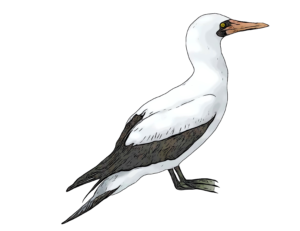Identification
Adults easily distinguished from the archipelago’s other two boobies through their blue feet. Both adult and juvinile’s streaked heads are diagnostic within the archipelago.
Description
Adult has distinctive bright blue feet, dark brown back, dark brown head and hind neck streaked white, pale yellow eyes, a greyish bill with a blue-grey base and adjacent facial skin, a white patch on its upper back and a small white patch on its rump. Male has darker brown head and hind neck than female. Juvenile similar to adult, but with greyish legs and feet and irregulr white patches on its back.
Galapagos Distribution
Found throughout the Galapagos Marine Reserve. In the Galapagos, breeding occurs on most islands South of the equator.
Global Distribution
Found across the Gulf of California and along the west coast of South America from S Peru to to Panama.
Status in the Galapagos
Common resident.
Conservation
Vulnerable. With a total population of roughly 10, 000 mature individuals, this species is ranked as ‘vulnerable’. It has been extripated from Rabida and Santiago and populations across Santa Cruz and southern Isabela have been greatly reduced. It is threatened by invasive predators such as cats, dogs, pigs and rats that prey on its eggs young.


